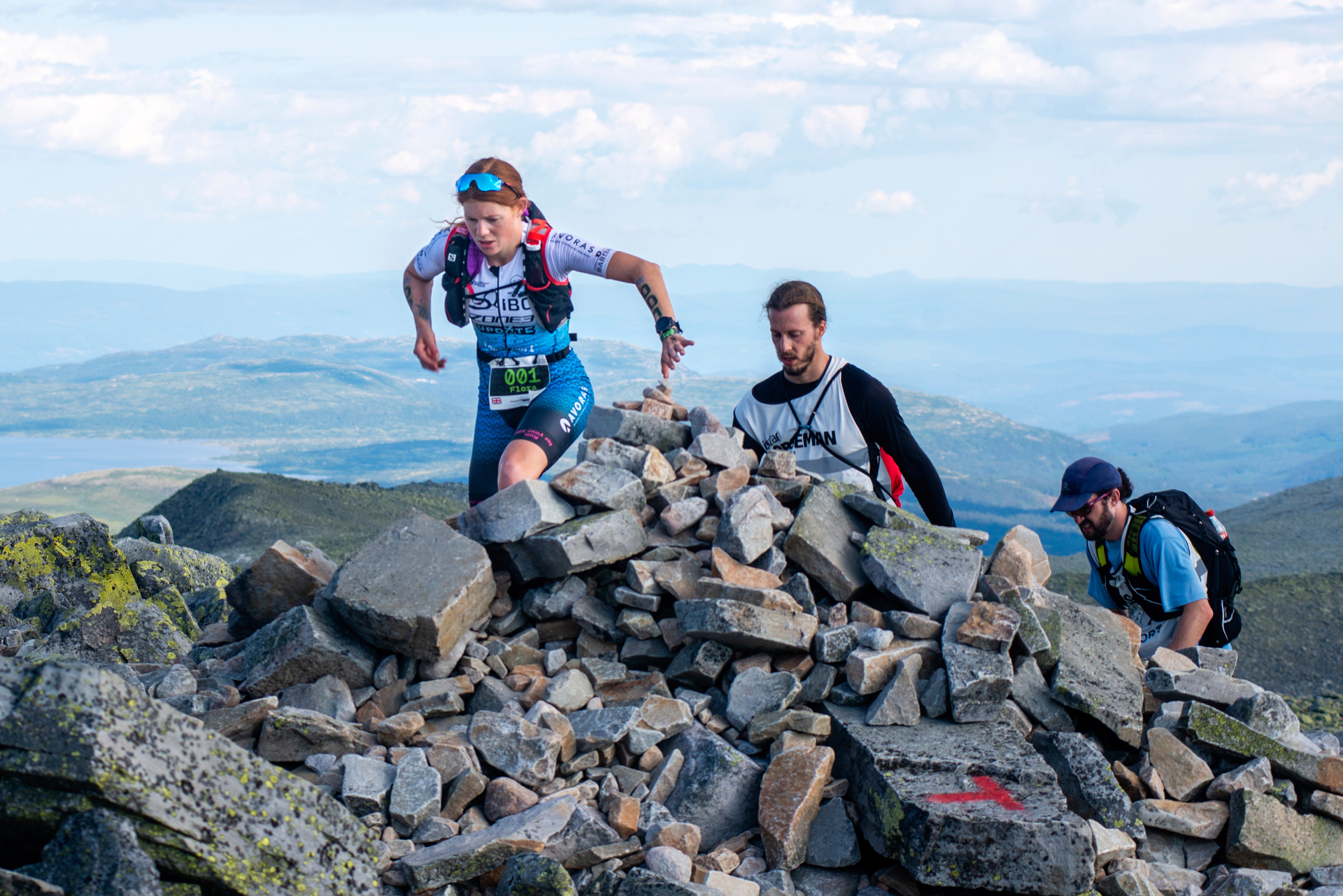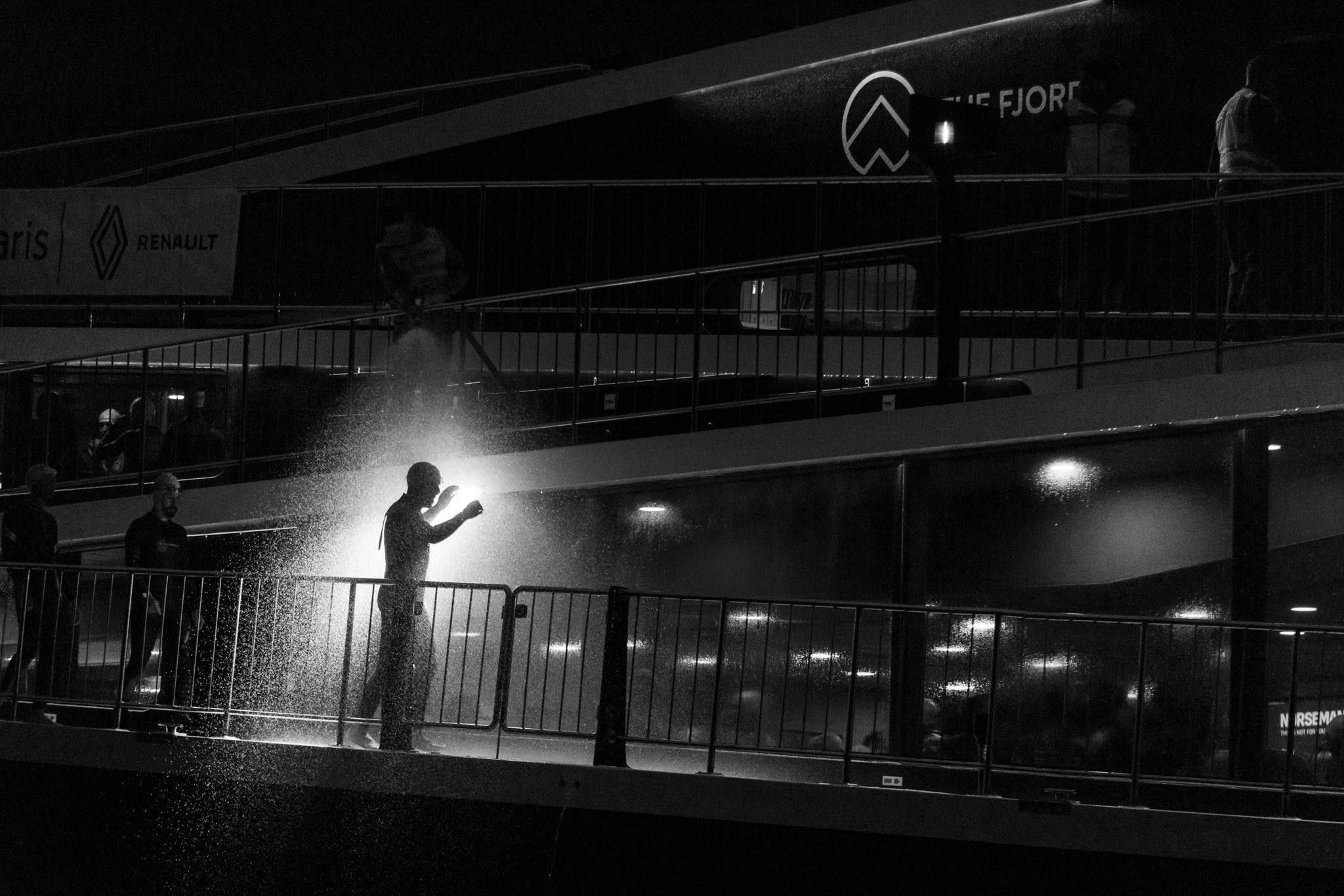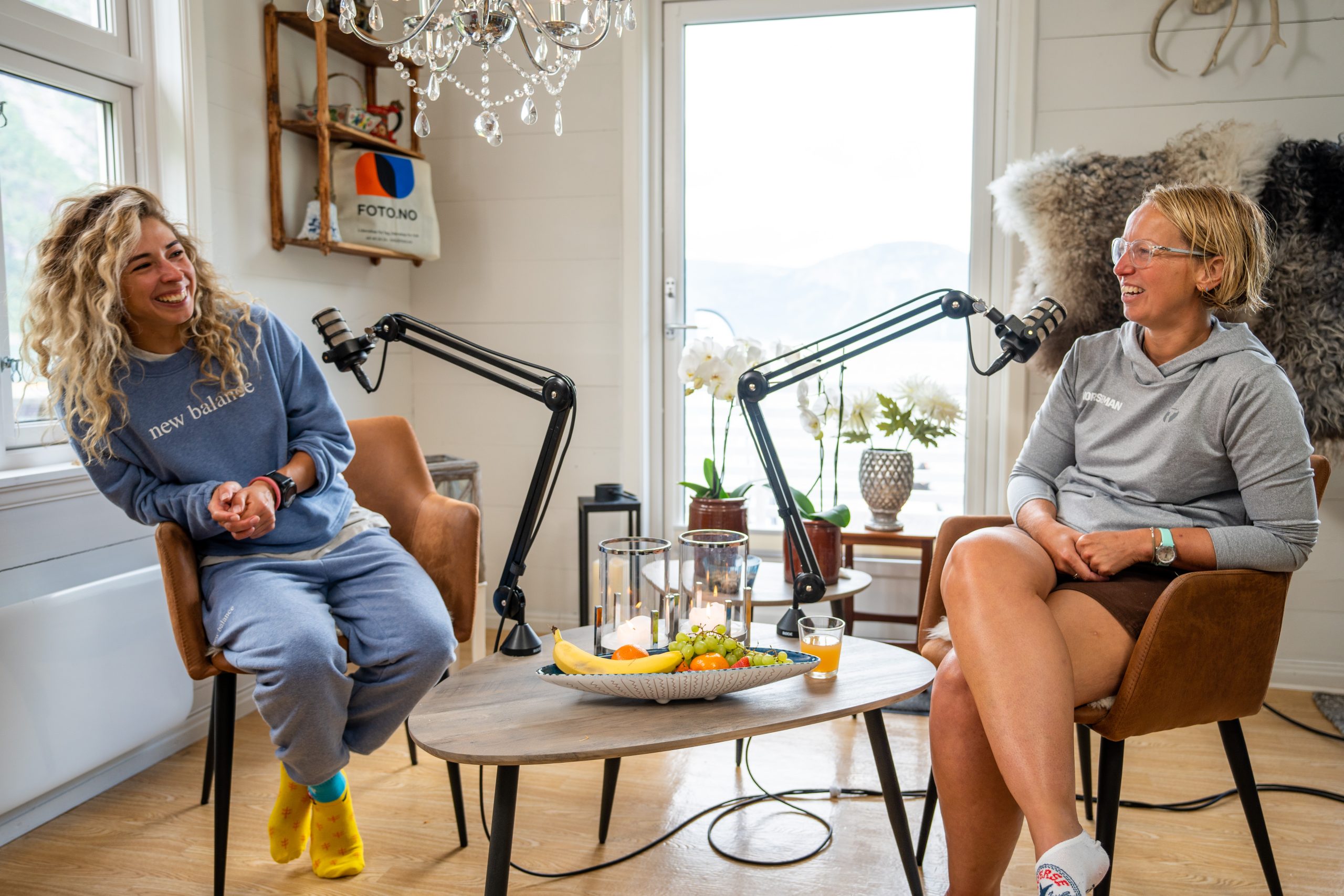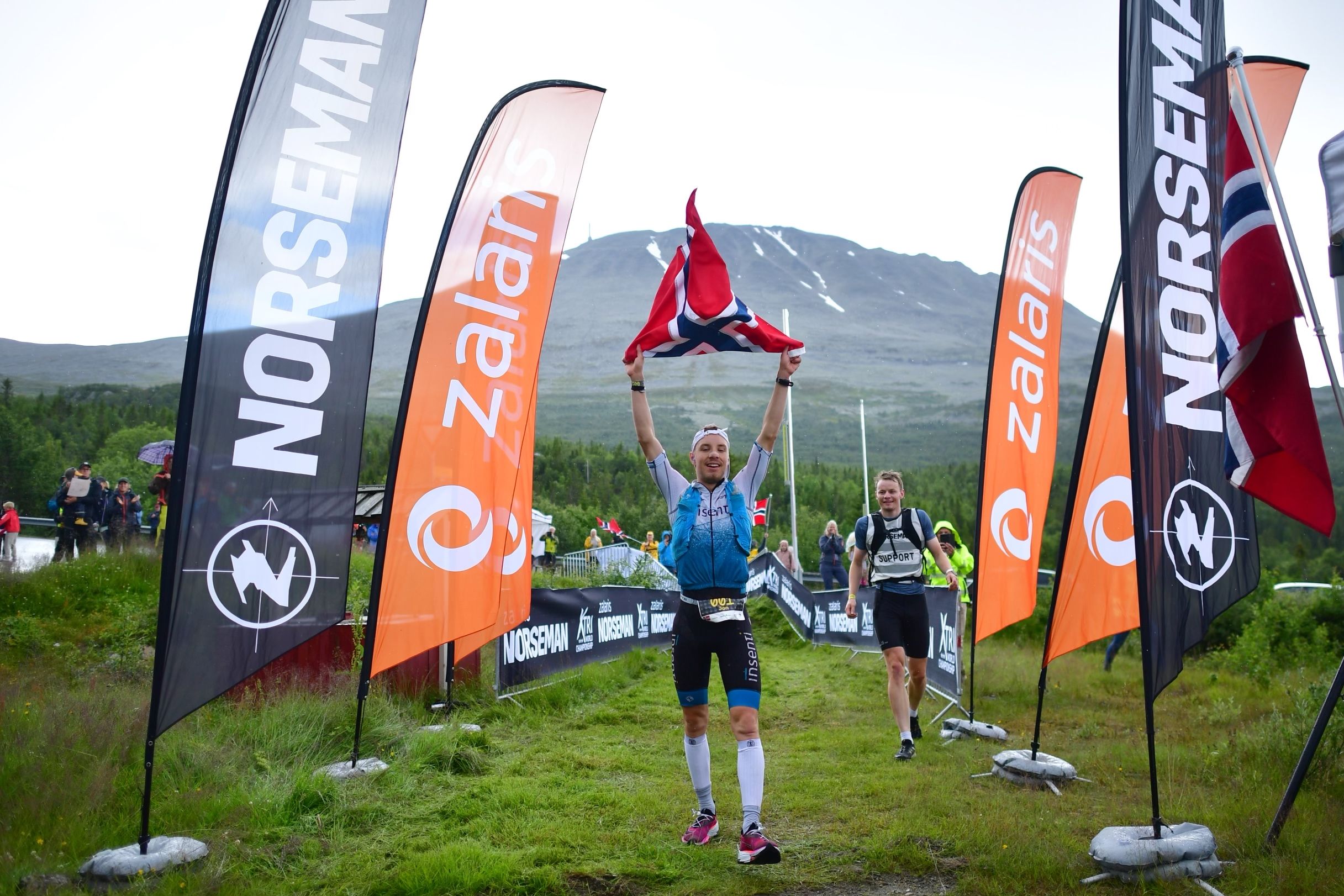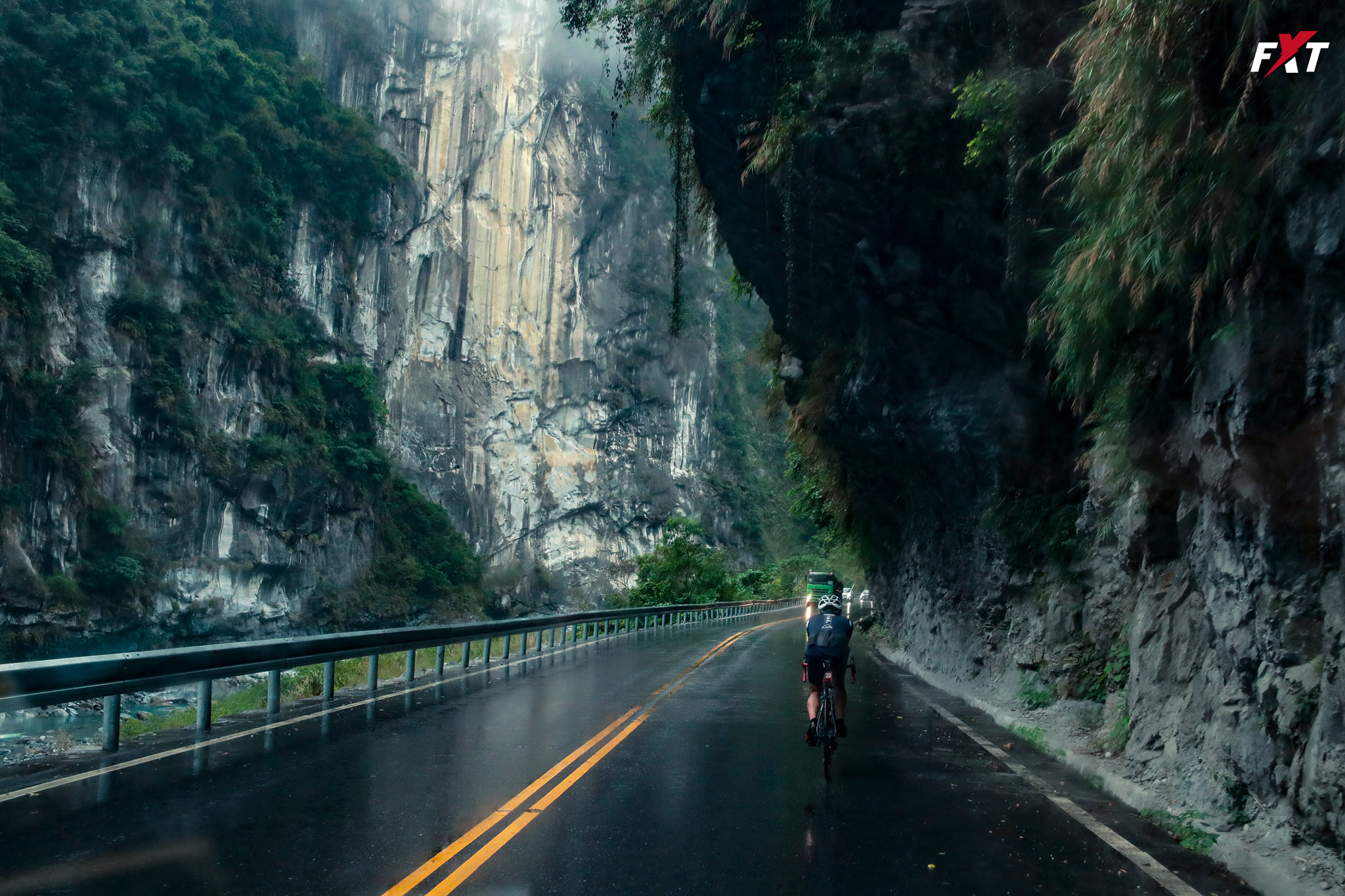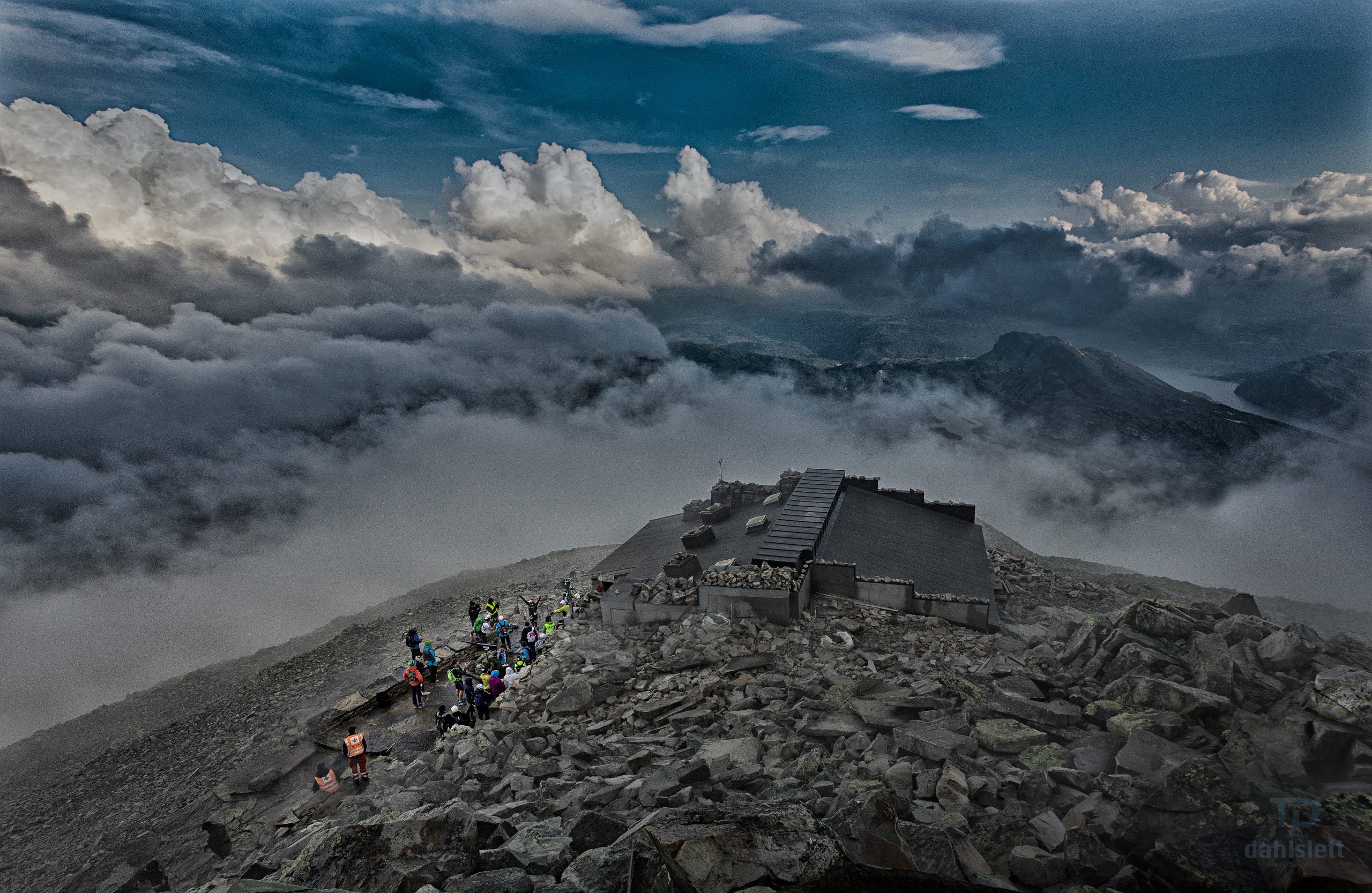In this episode of Norseman Radio you’ll learn these three key things:
- How to find a really great support crew for your Xtri race
- Mindset techniques to help you push through dark training days
- How best prepare yourself for Norseman’s Zombie Hill
Scroll down for the full episode notes with accompanying images.
Listen to the episode on:
————
Adelaide: It gives me great pleasure today to welcome Flora Colledge, who has raced in many xtri races, and last year came second at the Norseman Xtri World Championships. Welcome Flora!
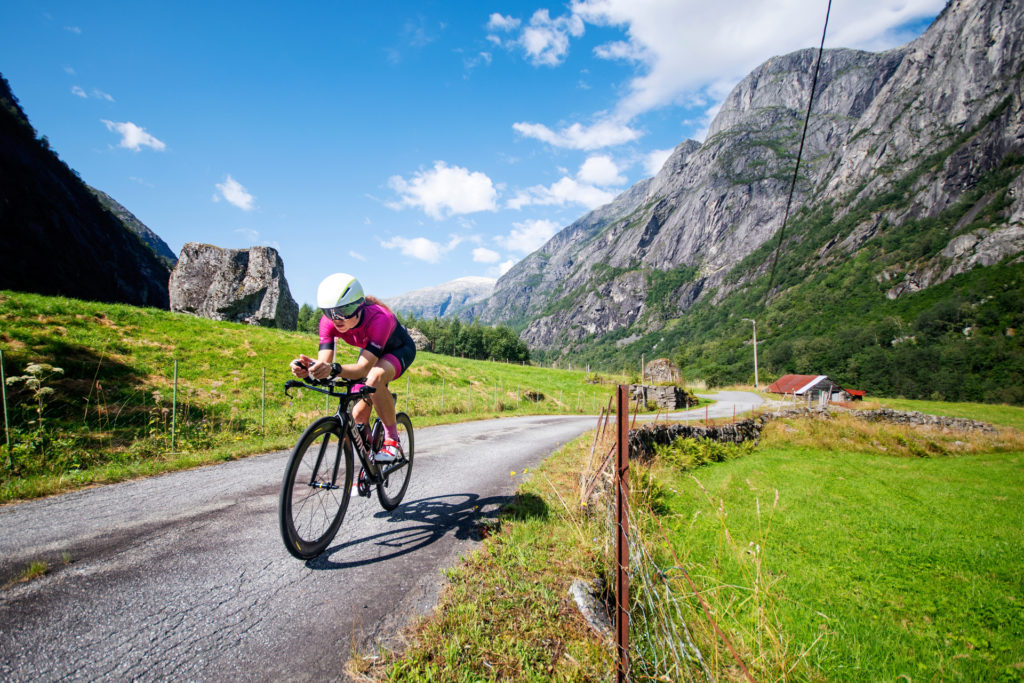
Flora: Thank you so much for inviting me!
Adelaide: Would you please tell us who you are and what it is you do in the world today?
Flora: I’m an Xtri athlete and post-doc researcher based in Basel, Switzerland, where I work and do my training. That about sums it up!
Adelaide: It sounds really incredible to be a researcher and Xtri athlete. We’re going to dive into your research later, because I know it partly relates to triathlon.
But first, could you please tell us how you started your journey into triathlon?
Flora: Yeah, I came to triathlon very late. I came to competitive sport, generally very late.
I really didn’t do anything competitive until I was about 23 or 24, when I started running, and I wasn’t particularly great, but I took it very seriously and trained very hard, and really focused on it a lot, but I just kept on getting injured.
And I think a lot of people who end up in triathlon have the same sort of backstory, running is very hard on the body, especially if you started a little bit later in life, and so it just made sense to switch to something where all the cross training I was doing would actually pay off.
I’d done some swimming as a kid, so I was kind of comfortable with it ad I thought, ‘Oh, well, you know, anyone can ride a bike.’
So I made the switch to triathlon when I think I was about 27 and did my first triathlon, and I was hooked immediately! It was just so much more fun than running and so much more potential for improvement and things to work on, and the courses were more interesting. So yeah, I came to it late, but have hugely enjoyed it since then.
Adelaide: Which race distance did you start with?
Flora: It was much shorter than an Ironman. It was a really tiny local race. I think it was a sprint distance and the swim was in a pool. The bike course was this nightmare of constant 180 degree turns and the run was on a track. It was really, really tiny, but I immediately loved it!
Then I think about six months after that, I was doing my first half Ironman. The first ironman distance race I did was actually an Xtri World Tour race and that was Swissman!
So I moved up to the longer distances pretty quickly. I think I did Swissman about a year and a half after starting triathlon.
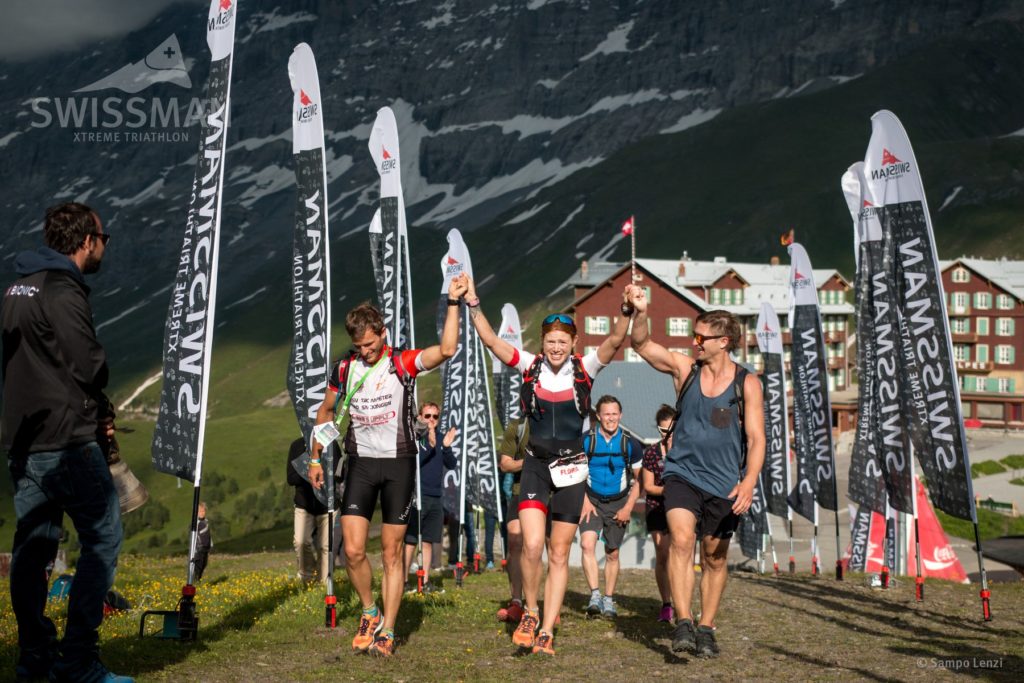
Adelaide: What drew you to the longer distances as opposed to the shorter ones?
Flora: I just wasn’t particularly great at the short fast stuff. It was always a matter of seeing what I enjoyed and what I did well at, and that was definitely always the longer distance.
I never had a problem with the idea of just keeping going, but I don’t really have a lot of explosive speed. So the long distances made sense and the races just seemed so much more attractive, interesting and challenging.
When you think about the distance that you just cover on a bike in a long course triathlon, most people don’t even want to drive that far! So it was just this idea of this thing that seems so tough and so challenging, but just within reach, and that was something that I found really appealing.
Adelaide: When you were growing up, were you always interested in the more challenging aspects of sport or adventure? Or was it something that you came to, as you said later in your life?
Flora: I don’t think there was really much focus on it when I was a kid. I certainly wasn’t interested in competing and didn’t really train for any sports. My dad was a mountain climber, so I would do some hiking with him. I think he shared his passion for the mountains a little bit with me, and I was never afraid of just swimming for ages in open water in the sea. That was something I would do quite a lot and it never bothered me, but it’s certainly something that I’ve discovered a lot more as I’ve gotten older.
Adelaide: Where did you grow up?
Flora: In Belgium. I was born in Belgium, grew up there and studied in the UK. Then came to Switzerland to do a PhD and have been here ever since!
Adelaide: Wow, that’s pretty cool.
Why did you go from doing your first triathlon to the half Ironman to XTRI, why did you not just go to Ironman?
Flora: I did do one Ironman and I just didn’t like it.
It’s the same distance, but it’s so different.
There’s just so many people around you and it’s such an enormous starting field. I think most Ironman’s have about 3,000 people in the start and usually the conditions aren’t that challenging, because they want everyone to get round the course.
That kind of racing just doesn’t appeal to me and doesn’t do anything for me.
But I came to triathlon late, so I was learning about it when I was 29/30 and as soon as I heard about Norseman and saw a picture of it, I was like, ‘Oh well, that’s a real challenge’.

I think it was one of the first years that Swissman had been running and I was like, ‘Oh well that’s in Switzerland, I can just do that.’
So I signed up as soon as I could and got a place straight away and just didn’t really look back from there. It was so clear to me that this was so much more my passion than Ironman.
Adelaide: When it comes to Xtri races, do you find you’re passionate about the challenge or the adventure, or bit of both?
Flora: It’s both. It’s the unknown. I mean, you’re in really tricky terrain and there’s some races that I’ve done a couple of times now, but some of them when I go out there for the first time, it’s not like you can really do a course recce of some of these places. They’re really putting you in the middle of nowhere, so you’re just exploring it on race day.
It’s just this enjoyment on the day. You can be in a race setting, but you’re just on your own in the middle of nowhere, there’s no cyclist in front of you, there’s no cyclists behind you. It’s just you and the course. I just love that I can focus on that. I love sharing it with my crew, they do an incredible job. So it’s almost like a different sport for me and it gives me so much more.
Adelaide: Now you’ve mentioned your support crew, how do you find your support crew for each race?
Flora: They’re just my friends and workmates. They’re just the best friends in the world, you know, this is what they do during their holiday time. They just travel with me to all these places and let me yell at them and ask them for food and make them do all kinds of things.
They do an incredible job and it’s been so amazing to share all of these experiences with them and travel to all these places. It’s been great that we’ve had some really good races together, but they make it possible.
The one exception was when I went to Patagonia to do Patagonman and it was just a bit too far for them to go. So the race organisers set me up with a local woman, Nedia, and she was just incredible as well. Absolutely wonderful. This was also the other lovely part of the race, because now I’ve got this new friend!
It was just an incredible day to share with her and to see that it can work so well with someone who you haven’t necessarily met before, but the spirit of the race sort of brought it together.

Adelaide: Did you meet Nedia on race day or were you able to meet before?
Flora: We met before race day, otherwise that would have been a bit late to start hashing everything out at 2am. We met 2 days before and we’d been emailing each other a little bit in the weeks and days leading up to the race too.
I had a race plan of where we were going to meet each other on race day and what I would need to eat and drink. Then she just sort of took it and ran with it and went above and beyond, and was unbelievably organised. Everything just worked so smoothly, but we were kind of chatting about it in the days prior to the race.
Adelaide: With your friends who you’ve done the other Xtri races with, are they the same friends who travel with you each time?
Flora: Yes, they’re very good friends, especially this year! They’re coming to three Xtri races with me and two of those involve quite a bit of travel.
They also train to be a better support crew and there’s so many things that we practice in advance.
It just gives me so much energy on the course as well, when you see your friends and they’re kind of in it with you, and you just want to give your best for them. They can just lift your mood up if you’re having a dark patch or something like that. So it’s such a special part of Xtri that you get to share that with them.
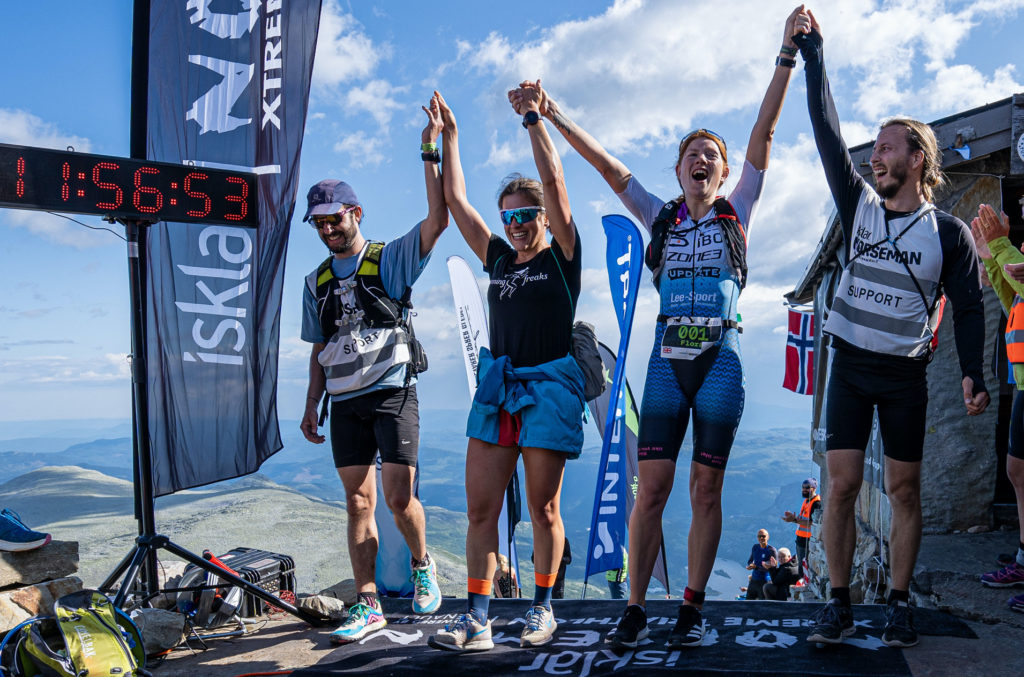
Adelaide: I met them on the Norseman course last year, because we were following you and your support crew on Instagram Stories, and they were so, so friendly and funny.
If someone is racing in Norseman or an Xtri race for the first time this year, or if they’ve raced a couple of times, what do you feel is the number one thing for you, which has transformed your team into a really, really great team?
Flora: I believe the most important thing is that they’re really passionate about it as well. It doesn’t mean that they have to be passionate about you doing a certain time or winning or whatever it is, but they just have to have a passion for the race experience, because we’ve definitely found that it really doesn’t matter if someone’s a good athlete or not. If they’re not really interested and they’re not engaged, then it just won’t click and you’ll have a tough time on race day, no matter how much experience they have.
But as I said, as I discovered in Patagonia, you can take someone with no experience who doesn’t even really know what a triathlon is, but if they have this passion for the race, and just enjoy it, then that energy is going to be there on race day, and they’re going to give 100% and you’re going to feel great.
So that’s just what you need: passion and energy. Just people who when you tell them about the race, they say, ‘That sounds amazing!.’ That’s all you need for a great crew, people who are caught up in the magic of this kind of racing.
Adelaide: That’s a great tip because I think, from my perspective, I’ve not done an Xtri yet, but I would have gone for someone who’s also a great athlete. So that’s really interesting to know that it’s more about their passion and energy.
Flora: Absolutely, that’s definitely been brought home to me so many times.
At the end of the day, depending on what section of the course you’re on, if you want your support to be with you, to be doing the last part of the run, or the climb with you, most people can stay even with the very top guys at the speeds we’re going at the end of one fo these races.
It’s really not about athletic conditioning, and it’s all about spending time with someone who’s excited and passionate about it.
If your day is going well or if your day is going badly, that person is just going to give you the energy and the joy and make the experience good, no matter how the race turns out.
Adelaide: Do you have a blueprint for how you’re going to work with your team and what you’re going to do on race day for each Xtri, or do you find each race requires something different?
Flora: They sort of require different things, because the rules are different for different races.
For example, in Norseman, you can’t have someone with you on most of the run, but in Swissman you can. So for Norseman, they’ll be kind of stopping their car on the road to support me on the run, and we have a plan for that. Whereas in Swissman, I can just have someone with me on a bike and I don’t really need a plan for my nutrition, I can just ask for whatever I want when I want it. So there are different things that are race specific.
The joke with my crew is always that I give them a piece of paper and they’re like, ‘Oh Flora has given us the list and now we can ignore it!’, because whenever I turn up, I just ask for something completely different! So we do have a plan, but these races do demand flexibility. Your appetite for whatever you’re eating on the bike might change, things like that. I think the best approach is when your crew has a vague idea of how the day will play out, but are ready to react quickly.
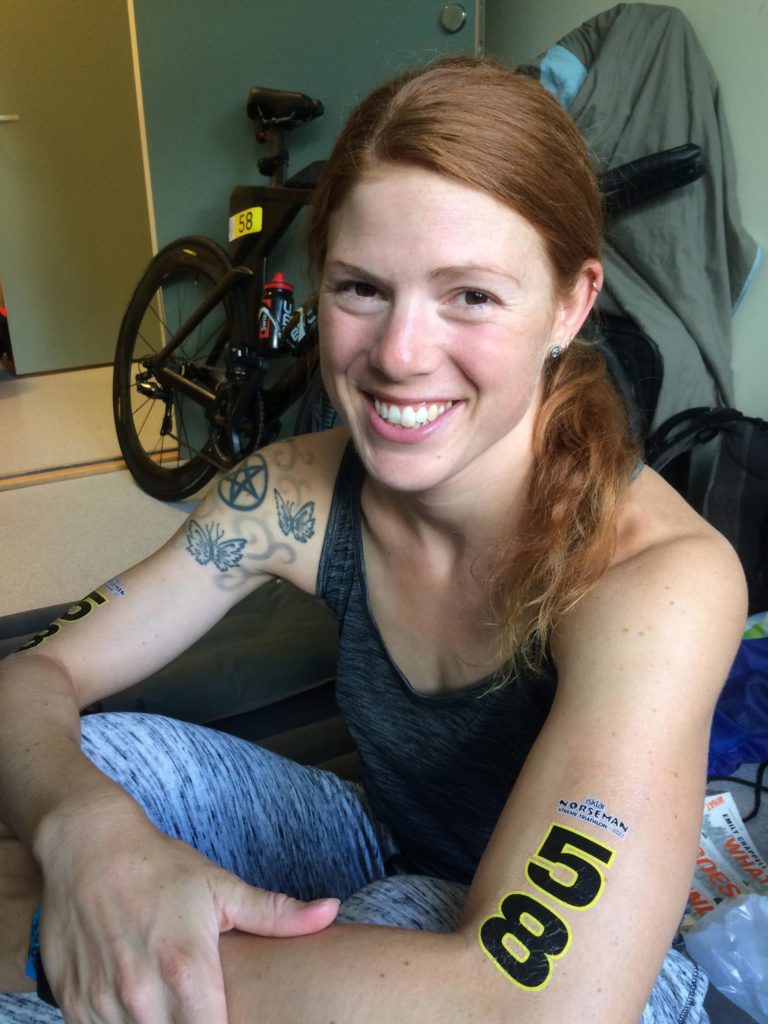
Adelaide: What’s your favourite snack to have on the bike and the run?
Flora: On the bike it’s Snickers! That’s one of the main things I eat on the bike, Snickers and little Nutella or ham sandwiches. I won’t really have any gels on the bike, as I just don’t really feel like I need them. I don’t have digestion problems and I just don’t want to be eating gels for 12 hours or whatever it is. On the run I will go for gels more, but I’ll also eat little Milky Way’s! They go down pretty well!
For me, I can digest anything pretty well, even when I’m running and it’s a really long day and you’re probably really suffering, so at least look forward to what you’re going to eat.
So, yeah, it’s basically a lot of little chocolate bars and I have an energy drink that I’m drinking on the bike. But later on the run, it’s definitely quite a bit of chocolate.
Adelaide: That’s awesome, I love the chocolate theme!
How many Xtri races have you done now?
Flora: I’ve done three Swissmans, two Norsemans and one Celtman. So six all together.
Adelaide: What’s been the most memorable moment out of all six races for you?
Flora: There have been so, so many in so many different ways, but I guess the really emotional moment was the first time I won Swissman, which was my second triathlon.
I’d kind of wanted to do well the year before, and it just hadn’t gone right for a lot of different reasons. Then the next year, I came back and I prepared really hard. I knew for quite a long time that I was going to win and when I finally got close to the finish line, I just started crying and crying. I’d finally done it and it was this race, that I cared so much about. So that definitely stands out for me.
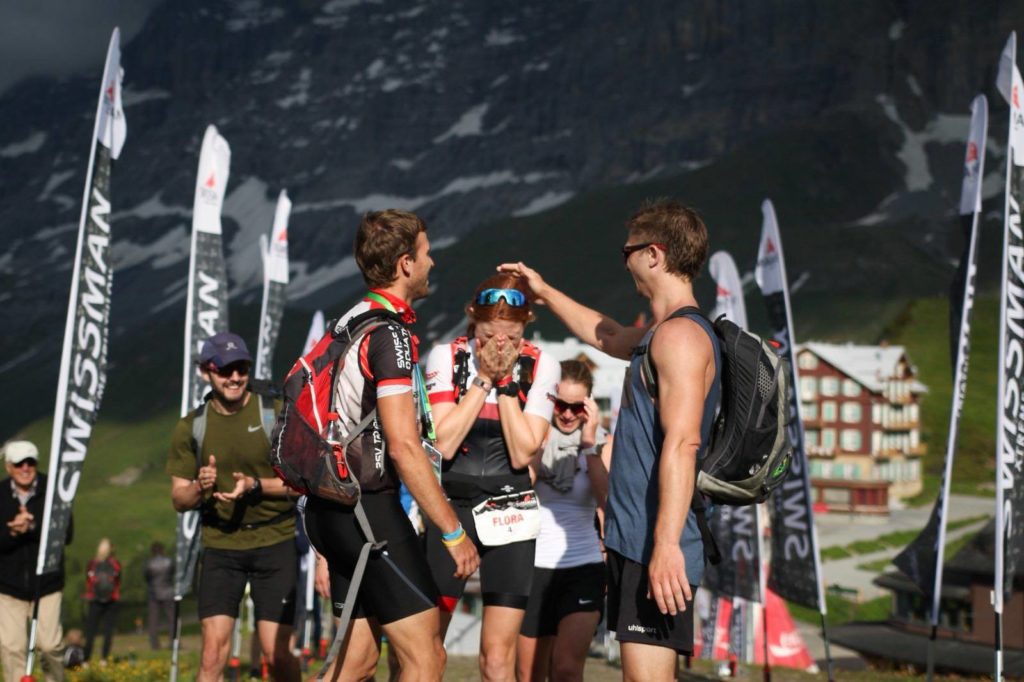
Adelaide: That’s incredible, congratulations!
Flora: Yeah, I’d say that was the moment where for the first time I did well at one of these races, because up until then, I’d really cared about them, but it was just me. I thought I could do well, but I’d never really been able to show it and that was the moment when I was like, ‘Okay, I’ve finally done it!’
Adelaide: When you started your journey as a pro triathlete who competes in Xtri races, did you have the goal to win in mind or has it transformed into this?
Flora: I did have it as a goal for absolutely no good reason. I mean, I was really, really bad when I started, not particularly talented, not really technically skilled at all and I was starting it at 27 years old, but I somehow just thought I could do it. Especially when I saw races like Norseman and Swissman, I was like ‘Oh, I can definitely do that.’ – for no good reason!
I guess it was just this spark that ignited in me. I was really passionate about those races and that fed into the motivation to work really hard for them. This is just the type of racing that suits me. It feels like it took me a long time to get here and there were definitely a lot of dark days on the way, but somehow I did always think like ‘Yeah, that’s what I’m going to do.’
Adelaide: How long did it take you from your first triathlon to winning Swissman?
Flora: That was four years, which now doesn’t sound like that long at all, which is kind of funny.
I guess if other people are struggling in training, or if it’s feeling like a long road, it sounds like nothing now, to go from never having done a triathlon to winning a big race and a year later getting a pro licence, but I had to go through every one of those days to get there on all those four years and I was not doing well on most of those days.
It was really a question of, just keep going because you enjoy it and because you think you can get there. So even though now it seems like it went quite quickly, it was definitely a struggle.
Adelaide: What’s one of the main techniques you use when you’re having a dark or an off day?
Flora: My main technique is one that my coaching group really preaches and it’s one that I think works particularly well for XTRI and it’s that you don’t have to worry about what you’re doing in terms of speed on any particular day.
Some days you’re just not going to be fast, you’re just going to feel bad and you just have to grind through it. Don’t start telling yourself that you’re terrible because you’re not hitting a particular speed or whatever.
I don’t even look at my paces and speeds, you just need to find a way to finish the session. Just find a way to keep going and if you can do that, you’ll have got something out of your day, and you’ll have developed the skill of just finding a way to keep going. You’ll also find that on race day and that 99% of the people around you won’t have that.
So you don’t need to be going particularly fast. You just need to keep going and that’s something that’s made a huge difference for me and I think really works.

Adelaide: What’s one of your favourite ways to help you to just keep going and to push through that barrier?
Flora: Partly it’s thinking about, well, I have this race or goal coming up and I want to do well and partly, it’s just a very simple thought of, ‘I can’t control a lot of stuff. I can’t control who I’m going to be up against in a race. I can’t necessarily control if I feel bad right now, but I can definitely control if I give my best or not.’
That’s all you have to do, just that one thing, just give your best now, and there’s no way that if you don’t just do that every single day, it won’t pay off somehow, even if you don’t see it for a while.
Adelaide: I absolutely love that.
Do you have the same thought about giving your best when you’re in the race and you might be going through a dark patch?
Flora: Yeah, absolutely. It’s funny because dark patches happen so much less during the race. But, yeah, there’s definitely moments when that happens, especially in Norseman.
The run at the end contains a huge amount of mental challenges. You can’t always change a huge amount about your performance in the middle of a race, but if you know that you’ve got these months and years of just getting through it, and always knowing that, okay, even when I was feeling bad, I could always just take that next step and stay focused, and right there you’ve got a big advantage.
I think that when you’ve suffered through it enough in training, it will pay off by becoming automatic in races. All you really have to do is just grid it out in training, and then that’ll be the sort of athlete you are when you get to the race.
Adelaide: I’d like to circle back to the Norseman moment you’ve just mentioned!
What is it like to finally be on that ferry, knowing you’re about to jump?
Flora: To be honest, the jump part of it is very iconic, but that’s not the thing that I really focus on.
For me, it’s more just after the jump, when you’re in the water and you’re starting to get a bit cold and you’re waiting for the start. It’s knowing that you’re going to keep your focus there, because you’ve got this long day stretching out ahead of you and the jump and the swim is about 10% of that day. So usually I’m not so much focused on the moment of the jump, as kind of just trying to stay as calm as possible, because the swim is a very little part of the journey that’s ahead of you.

Adelaide: How do you keep calm in that moment in the swim, between the jump and starting the swim?
Flora: I just try and think about all the times that I’ve done exactly the same thing. Just try and focus on all the swim trainings that I did when I had to get up early in the morning and it was dark and it was cold and the swimming pool was cold. I did it every single day, and the races that I’ve done before.
It’s just telling myself that this is nothing new, it is a race and it is a very important race and it’s a world championship. But I get up when it’s cold every day and swim 4km. Now I just have to do that again. So that’s the main thing I’m thinking of.
Adelaide: What was the greatest challenge you found about Norseman?
Flora: The first year I did Norseman, it was turning that corner and seeing Mount Gaustatoppen, because you’ve been running on this dead flat road for 20Km and you can run a decent pace. So you do hurt your legs and then you just see this giant thing in front of you with this tiny tower at the top. And you’ve seen the footage from previous years and you say I I have to get to there, and another part of you is like, well, that’s impossible. It just looks so far away.
Norseman definitely has a certain monotony about the run course that other races don’t and that’s what makes up some of its toughness, that there’s no kind of change in terrain until the end to distract you. What you’re going to have to go through, the suffering is with you and in front of you the whole time. So that first moment, which I’m luckily now prepared for, was definitely the major challenge.
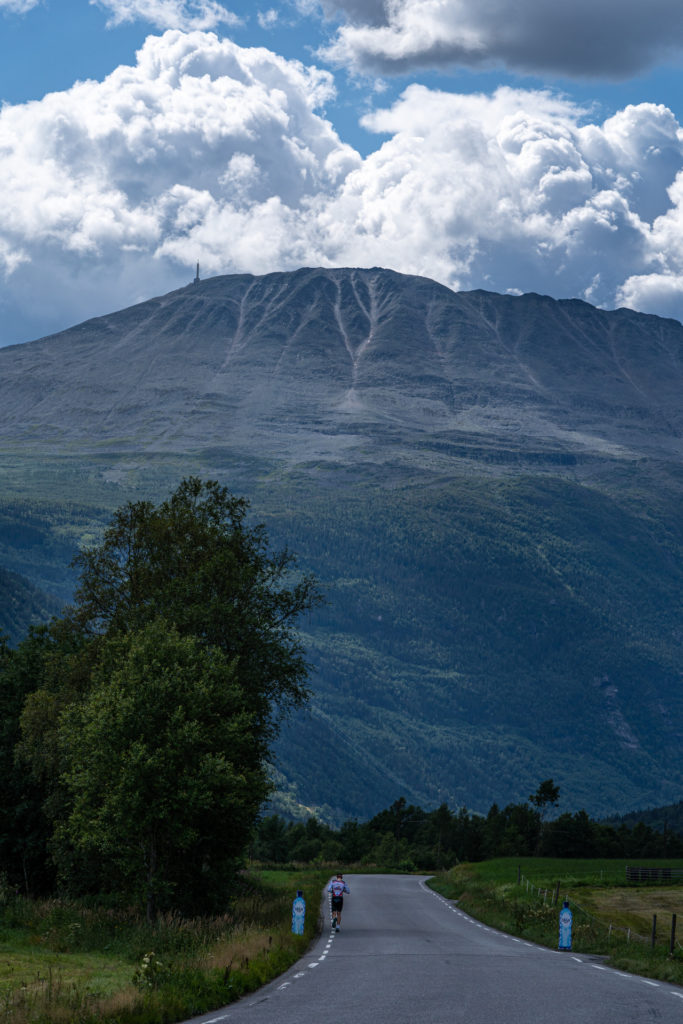
Adelaide: How did you train for that?
Flora: Well, I didn’t know it was coming and up until then, I’d only done one Swissman just before I did my first Norseman and I didn’t run up the last climb at Swissman, I just hiked it.
Coming into Norseman I didn’t really know anything about it and I was like, ‘Well, I’m just going to do that.’
Then suddenly I was in a situation where I was in third place, but fourth place was really close behind me. I suddenly realised that at the foot of Zombie Hill I’m going to have to run the whole thing. I don’t think I can do that, but I have to.
That was a really pivotal moment, because that was where I sort of showed myself that I could, even though I didn’t think it was possible at all.
Now I know how to prepare for Zombie Hill and attack it a bit better. It was almost special not being prepared in a way, because afterwards I was like, ‘Well, I literally thought there was no need to run up that, but I did it anyway. And now I know I can do it again.’
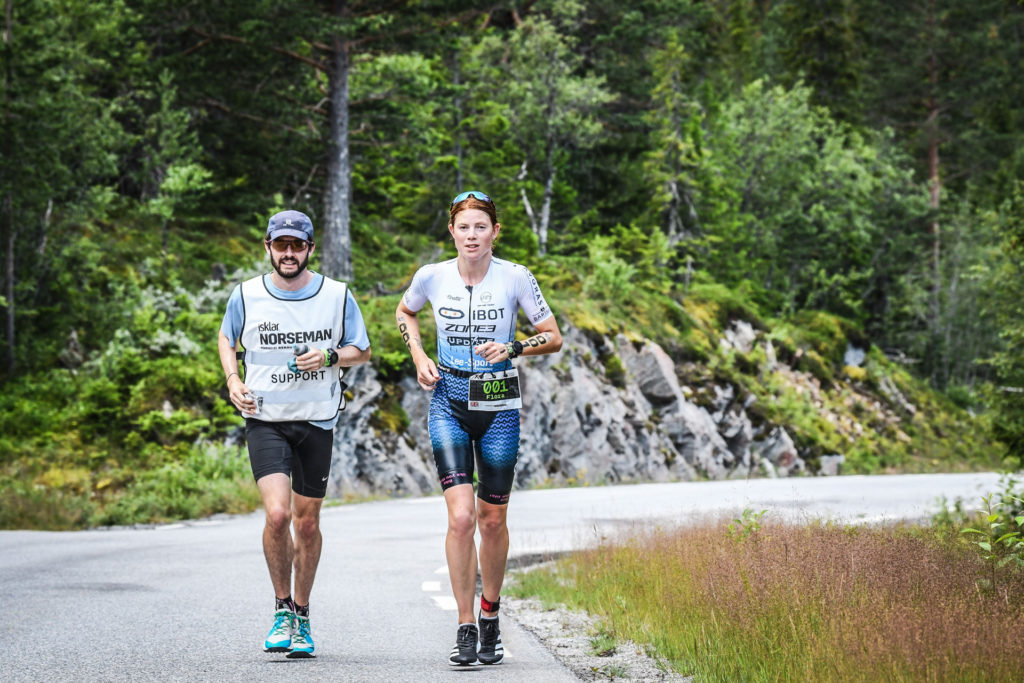
Adelaide: For someone racing Norseman this year, what would you recommend they do in training to best prepare themselves, mentally or physically, for Zombie Hill?
Flora: I think mentally you just have to know that change in steepness is coming, that you’ve got these flat 25km first, that you can run fast on and that you are going to hurt your legs on that run.
And then from there, it’s just uphill.
You have to be really ready to pace yourself for that uphill, because it’s going to keep going and keep going and keep going, and there’s really no respite. You just have to be ready and know your body well enough, that you can be kind of hurting, but know that you’re not going to blow up.
It’s about finding this sweet spot of just pushing forward and pushing forward, but also being ready to have this level of suffering in your legs, that you can basically hold for two to three hours.
Adelaide: I’m guessing we get that through training and racing?
Flora: I think that knowing that level of what it feels like is absolutely crucial and you don’t have to go and run for four or five hours or anything to find it, absolutely not.
What I would really encourage a lot of people to do is to not rely too much on pace or heart rate or anything like that, but to just know your body, and know what kind of effort you can sustain for a long time, because that’s the real crux of these Xtri races.
The pace you’re going at isn’t wildly fast, but if you just don’t get slower, over 11, 12, 13 hours, that’s when you’re doing really well.
A lot of people can kind of do the first seven hours and then they just blow up, because they didn’t really know what effort their body could hold.
So if you can learn what effort your body can deal with that’s right at your pain limit, that you can keep it going for hours and hours, that’s when you’re going to start to do well.
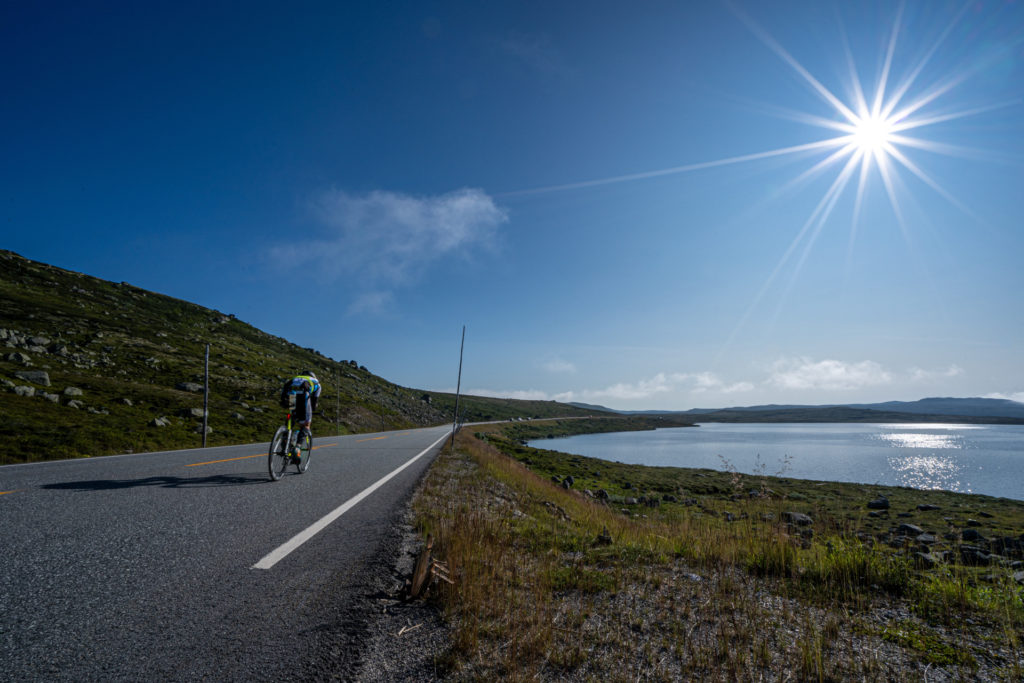
Adelaide: That’s a great golden nugget for us, thank you!
At the beginning you mentioned that you’re a postdoc, and I know that your research links into extreme triathlon. Would you please tell us more about that?
Flora: It does and doesn’t relate necessarily, so my research is in exercise addiction,
which is not yet recognised as a behavioural addiction in the Psychiatric Compendium, like a lot of other behavioural addictions.
However, it is a phenomenon that’s been pretty widely documented, that there are people who essentially exercise to a very, very excessive amount when they’re ill or when they’re injured and they can no longer work properly. They have trouble continuing decent family life or spending time with their friends. They’ll even lie about their exercise habits and feel terrible if they ever have to stop for any reason.
So it’s really people who can spend four, five or six hours in one go or split it over two sessions in the gym every day and can’t reduce it. Often these are people who don’t particularly have an athletic goal, although sometimes they might. It’s a possibility that some of them might have found their way to the Xtri world, that’s not something really examined yet. But that’s really the focus, finding out more about these people. What’s their psychiatric profile? How can we define this as a diagnosis? And how can we help them?
Adelaide: Have you found that a lot of triathletes may be slightly addicted to exercise?
Flora: So far from the group of people who we’ve identified, who do score above the cutoff for risk, none of them are triathletes.
It’s a little bit tricky because obviously, professional athletes and motivated athletes are going to tick a lot of the boxes that exercise addicts will also tick.
They’ll spend a lot of time, they’ll focus on it, they might have a reduced social life, but the key thing that differentiates them is that triathletes are usually not suffering under a big psychological burden that’s linked to their exercise. They have particular goals, they invest a lot of time in them, but they’re still able to focus on their work, they’re still able to recognise when they need to recover, because that’s important for training. So they take a little bit of time to do that.
But it’s when you’ve got these very, very rigid plans, and it’s all about the volume and everything else is abandoned, then the volume becomes more of a pursuit than any sort of race performance, then you might start to have concerns. There are definitely some triathletes who can fit this profile.
Adelaide: That’s absolutely fascinating.
Flora: It’s really interesting.
I can’t wait till I can tell you a little bit more about our results and what kind of profile we see with these people. But today, we still don’t know what it is about exercise that people enjoy. There’s a lot of theories about the things like endorphins, adrenaline or certain processes in the brain, but we still don’t actually know. So that’s another part of this research to try and understand what it is about exercise that humans enjoy, and why some of them seem to enjoy it a little bit too much.
Adelaide: I’m looking forward to hearing your results when they do come out!
Before we wrap up, would you please tell us your plan for your 2020 Xtri season?
Flora: Yes, it really is an Xtri season this year! Hopefully I’ll take part in five Xtris this year.
I’m hoping to Celtman, then a week later is Swissman, then I think there’s a long six week break before Norseman, then Patagonman and one month later is Himalayan.
I’m excited about doing the that double and I’m desperate to go to the new race in the Himalayas. Hopefully I’ll get a start spot for that as well. So that would be my five this year and I’m just incredibly excited about all of them.
Adelaide: That is really exciting, and is your same crew coming to each race?
Flora: The same crew is coming to Celtman, Swissman and Norseman, and then I think I’m going to travel halfway around the world to the others! The lady who supported me in Patagonia will be supporting me again this year. For Nepal I’ll figure something out!
Adelaide: A lot of triathletes find optimising recovery a challenge and you have five Xtri races this year, which is amazing, but how do you plan to maximise your recovery, especially when you just have a week between races?
Flora: Good question! I naturally recover quickly from long efforts like this. I’m not particularly good at super high speeds, but I am very good at recovering very quickly. So I’m just going to sort of trust that this is something my body can do.
I’ve raced back to back weeks before and I’ve been fairly comfortable with it. It all goes back to what I said about training and always giving your best. I definitely won’t be focusing on times or particular efforts or anything like that, especially in the week between Celtman and Swissman. It will all just be listening to my body, seeing how I feel and any efforts I do will be purely on feeling, just kind of small 30 minutes sessions to keep the body ticking over.
And just trusting that the work I’m putting in now is what’s going to show them and everything that I do in between those two races and in the lead up to the other races, is really just keeping the work that’s been done up until then, keeping it going, keeping it in the body, but not pushing myself and saving that for race day.
Adelaide: Incredible. I’m so excited to follow your journey this year. Sadly we have now come to the end of the podcast.
In the context of all that we’ve spoken about, is there anything else that you would like to add or share with our listeners?
Flora: I’m looking forward to seeing any of you who are at any of the many races that I’m going to go to this year! I’ve actually met quite a lot of people who’ve just reached out to me through the Xtri community and it’s really incredible. I love it every time. So just say hi, if you see me at a race.
Adelaide: Wonderful! I certainly will at Norseman this year! And now for the Quick Fire Round!
When you think of Norseman what first comes to mind?
Flora: The first thing that comes to mind is being sprayed by hoses on the run last year and kind of enjoying it, but kind of thinking that I didn’t come to Norseman for it to be 30 degrees on the run!
We got through it, but I would really like the really rough weather, so I’m definitely hoping for that one of these days.
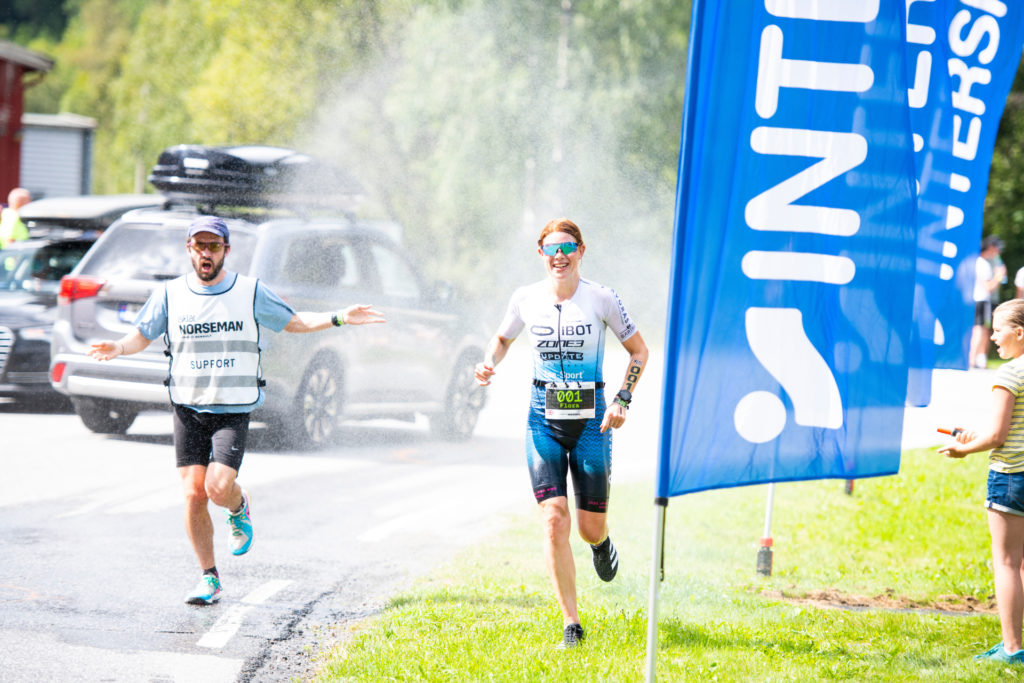
Adelaide: Which three athletes would you love to see race?
Flora: I’d like to see a good CrossFit athlete take it on, just to see how they do on the long endurance. I guess the top woman there is Tia-Clair Toomey.
One of the Brownlee brothers. Let’s see how they do. They like the harsh weather. So put one of them in there and then finally, I’d have to say Nicole Cooke, who used to be an extremely successful female cyclist and super gritty. I think if she could get the swim down then she would definitely do do well at Norseman!
Adelaide: Thank you so much for coming on Norseman radio!
If you’d like to follow Flora and get in touch with her, then you’ll find her on Instagram: @floracolledge
——-
About Flora Colledge
Flora is a professional extreme triathlete and postdoc researcher living, training and working in Basel, Switzerland. In 2018 Flora won Swissman and in 2019 went onto win Swissman and Patagonman, and came second place in the Xtri World Championships hosted by Norseman.
Connect with Flora on Instagram here.
About Adelaide Goodeve
Adelaide is a member of the Norseman media team. She also works as an “mental fitness” coach. Find out more about Adelaide here.
——-
About Norseman Radio
If you’d like to listen to interesting and intriguing stories around the Norseman Xtreme Triathlon and fully immerse yourself in the experience, then Norseman Radio is for you.
This podcast is not just for those who’d like to jump off the car ferry into Eidfjord and run up Zombie Hill.
You can find Norseman Radio on:
Connect with us on Instagram, Facebook, on our website and by signing up to our email newsletter!
